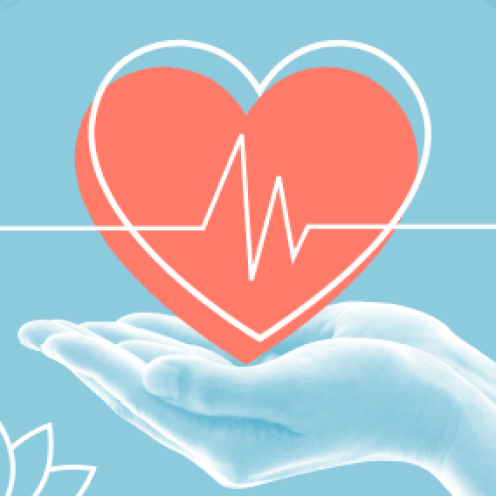Sign up to our free Living Well email for advice on living a happier, healthier and longer life
Live your life healthier and happier with our free weekly Living Well newsletter
Live your life healthier and happier with our free weekly Living Well newsletter

I cried just one mile into the London Marathon. Not from exhaustion – I’d trained to run the full course and despite my training not going to plan, I was ready to run 26.2. I ended up in tears because there’s nothing quite like stepping over that starting line. I felt transported seeing and hearing London so pumped up on love.
I hadn’t even crossed the line before I got my first sense of the crowds. They were overwhelming. And I hadn’t expected the noise to be non-stop but it was. Every corner of the course, all 26.2 miles of it, was lined with people cheering, clapping and shouting my name.
Spectators had come prepared with orange slices, tubs of Vaseline and bowls of jelly babies, and had drinks ready for runners they’d never met. Kids stretched out their palms eagerly for high fives. People shouted “you’ve got this!” and watched us run by with huge smiles on their faces. Live bands and choirs added to the noise, making it feel more like a festival than a race.
It was my first marathon and though I was running alone, I didn’t quite realise how much of a communal experience it would be.
Running a marathon had always been one of those bucket list goals I kept tucked away in the back of my mind. When I was a kid, my family went out to support my dad as he ran one, and something about that day stuck with me. I remember silently deciding that I wanted that to be me one day. After a few years of living in London and witnessing the city come alive for the marathon each April, I finally felt ready to try.
I’d been through a particularly tough personal chapter in the years prior, and the idea of training for something as big and demanding as a marathon felt like the perfect way to mark a new beginning.
But I wasn’t really a runner, not in the same way that some people really identify as “a runner”. I ran a half marathon back in 2020, but since then it’s only been the odd 5k here and there. I’m not a novice but I don’t run long distances for fun. So when I signed up for the 2025 TCS London Marathon, I knew I wasn’t doing it to break records or prove anything to anyone else.
I’d been working on quieting my inner critic enough to believe that you don’t always need to feel totally ready, that showing up imperfectly is still worth something. That mindset was my starting point.
This helped me through the experience because truthfully, my training hadn’t gone to plan. Although I didn’t want to admit it, in the lead-up, I’d done the bare minimum. Not out of laziness, but because it was my first time trying to stay disciplined over such a long training block. I didn’t fully grasp just how much preparation marathoners put in and I was carrying a lot of personal stress, both physically and emotionally, in the weeks and months before.
In the beginning, my training plan was optimistic and neatly structured, especially considering I’d gone from not running at all to suddenly trying to build up to 26.2 miles. I knew I wanted to run outside (despite the British cold), and eventually I started to crave it.
But then, one rainy morning, I rolled my ankle near the end of a run. What followed was a domino effect of challenges – flare-ups, a pulled calf, IT band pain, and in my personal life, a court case that brought with it its own emotional toll. With each setback, I had to confront a familiar internal voice urging me to defer to next year, to call it off. But I know how easy it is to accumulate excuses not to do something and how important it is to know when to push through.
I stocked up on some fun running kit to keep my motivation up. I found routes through my favourite parks and curated playlists that helped me run through the doubt. I also learned to truly listen to my body, knowing when to stop instead of pushing through pain.
I didn’t follow a textbook training plan. In fact, I ran far less than most people would recommend. But what I did do was meet myself with more compassion than ever before. I let go of perfection and control. I learned to care for my body not in spite of its weaknesses but because of them. And that, in its own way, became just as much a part of my preparation as the miles I logged.
Read more: I just ran my first Hyrox race – here are six things I wish I’d known beforehand
On top of all the setbacks I experienced, it was my first marathon. That’s an intimidating beast in itself. I arrived at the starting line running on poor sleep, nerves and adrenaline. But the important thing is that I showed up. I wanted to give it everything I had.
And even when I was struggling, which I quickly learned would be often, I stayed present. I didn’t expect to feel mentally grounded – I thought I’d be locked in a battle with my legs and lungs, or searching for distractions in music or a podcast like I usually did on long runs.
But instead, the atmosphere of the crowd kept pulling me back into the moment. Every time I thought, “I’m not sure how much more I’ve got”, something would snap me out of it. I’d enter a new wave of cheers, or notice a runner I’d mentally clocked as a pacer pulling ahead and I’d keep going.
I cried just one mile in. I’d signed up for this marathon on my own, trained on my own, and was fully prepared to run it on my own too. But that first mile shocked me. It felt like all of London, and then some, had lined the streets in support. A moving wall of strangers was cheering for every single runner. That kind of overwhelming love is something you don’t forget and it moved me.
I noticed a funny sign. A choir would appear around the bend. A stranger would scream my name and tell me I was doing great. A new neighbourhood would come alive in front of me, full of energy and colour. And just like that, another mile would pass by.
Read more: Best electrolyte drinks and tablets to keep you hydrated, tested by our fitness editor
It was the hottest day in London so far this year. Something a majority of us hadn’t trained in temperatures even close to. By mile three, the sun was affecting me. But the energy of the crowds carried me to mile 10. At that point, things got harder again, until I heard another runner say we had less than 20 miles to go. That gave me just enough to keep going.
I’d been hoping to see friends at mile 13, but in the chaos we missed each other. That’s when I really began to struggle. I started incorporating walking intervals – or, as some call it, jeffing – though in my case it felt more like the reality of my training catching up with me.
At that point I remembered the best advice I’d been given: take it all in and enjoy it. Especially this first time. So I fought the instinct to self-criticise and instead focused on staying present, doing what I could in each moment.
My pace slowed, and my predicted finish time began slipping away, bit by bit. I told myself it wasn’t about the time, but I’d still secretly hoped for something better. That’s when the dark thoughts began to creep in. I wasn’t just battling fatigue, I was nursing an ego that didn’t want to let go of perfection. But if there was one thing I had trained for, it was the mental side.
I adjusted, I breathed, and I let myself enjoy the pain, the struggle and the disappointment. Because, I told myself, “it’s all part of the journey, and without it, the finish won’t mean as much”
I was running through my city with thousands of others who, for that moment in time, were all chasing the same goal: to finish. And in the end, despite it all, I did what I came to do: I finished a marathon.
Read more: Are ice baths actually good for women? Experts explain
One thing I’d learned from talking to other runners during training was how important it is to have a “why” – a reason that keeps you going when it gets tough. I wasn’t officially running for a charity, but I still chose to support one that’s deeply connected to my own why. I ran the marathon for Solace Women’s Aid, an organisation that supports survivors of domestic abuse. It’s a cause very close to my heart. Despite everything it took to get there, crossing that finish line felt like a release.
Despite what people had told me, I don’t think anything could have prepared me for that feeling. The spirit of it and how thousands of runners, from elites to first-timers, became part of something bigger. That is probably what I’ll remember most, more than the finish line or my medal.
I’m still processing that it actually happened and though I found it physically hard, especially in the heat, I haven’t spared much thought for any physical pain I endured. The joy and gratitude are what have stuck with me. The gift of being able to run through one of the greatest cities in the world, surrounded by people who were there for no other reason than to lift each other up? The memory of that will last far longer than sore legs.
My finish time was 5:47 which is the slowest I’ve ever run. But I’d never run an actual marathon before. I’d also never experienced the kind of physical and emotional endurance the past six months demanded of me. So while it wasn’t the time I’d imagined for myself, it was the time I earned and that mattered more. My friends, family and loved ones still greeted me with pride and we headed to the pub afterwards to celebrate what this truly was: a win.
I didn’t train perfectly. I didn’t hit my goal time. But I stayed open to the emotion, the people, the messiness and the moment. And somewhere within all of that, I found the magic.
If you’d like to support Solace Women’s Aid via Niki’s fundraising page you can still donate here.
Read more: 18 best women’s running shoes, tested by experts














